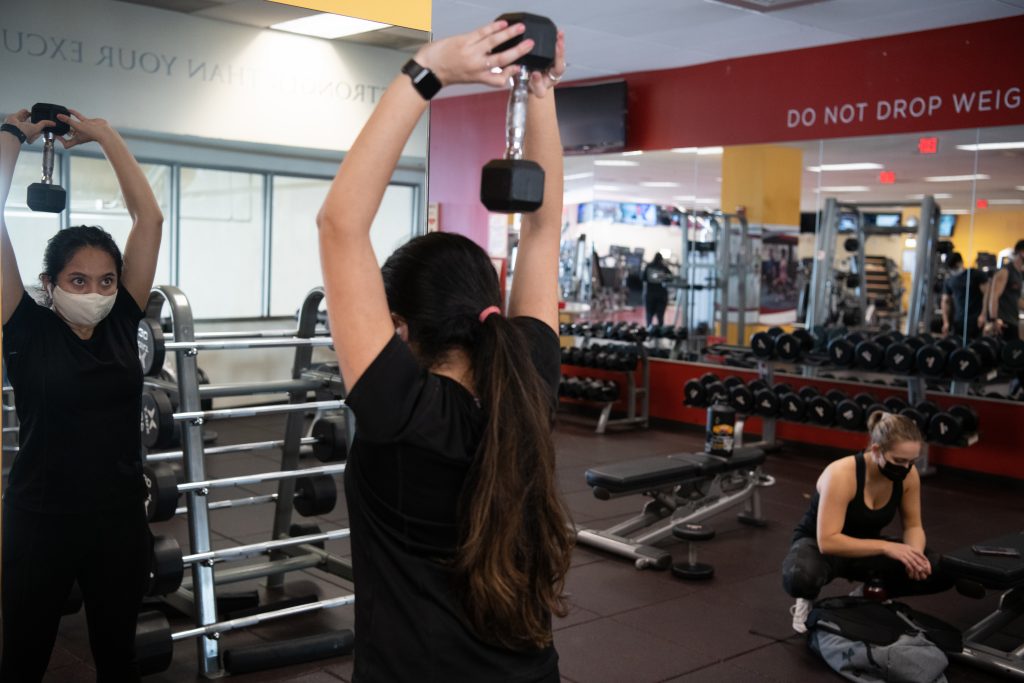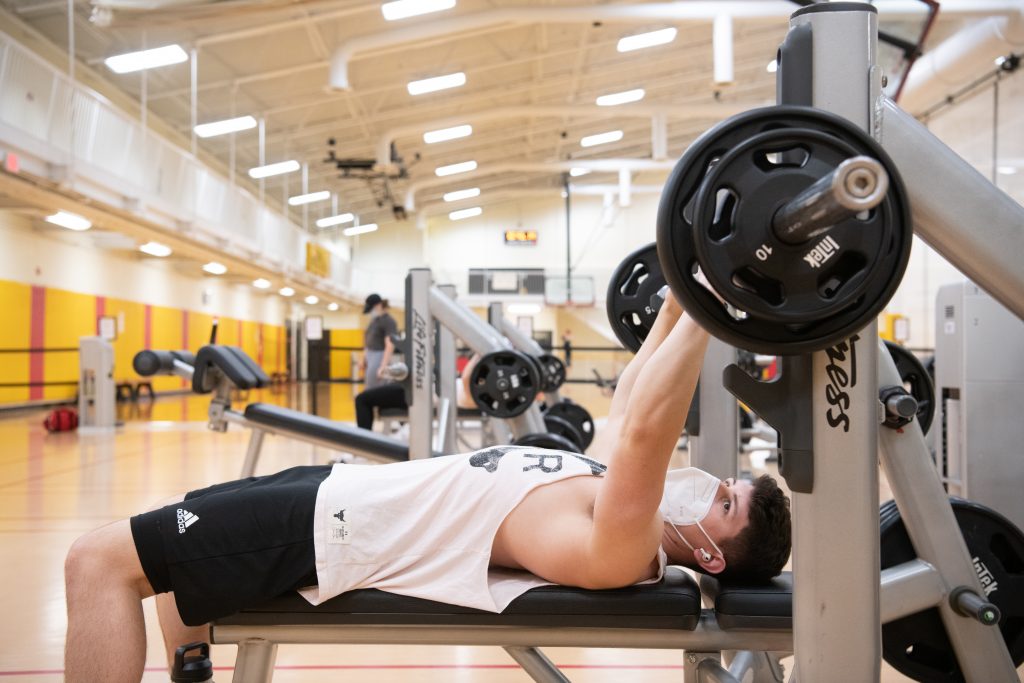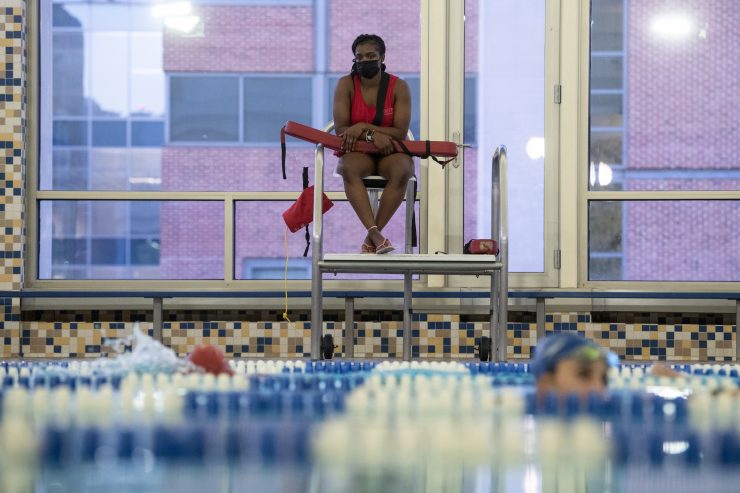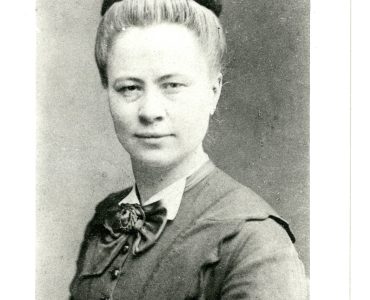When the COVID-19 pandemic forced many operations at the University of Maryland, Baltimore (UMB) to shut down in March 2020, University Recreation, Fitness and Wellness (URecFit and Wellness) closed its physical doors and moved many of its services online, offering its members virtual classes and other programs. During this time, URecFit and Wellness took numerous steps to adapt, including joining the Recreation Movement, which allowed students and employees to access online workout classes from more than 45 colleges and universities across the country. URecFit and Wellness partially reopened in June 2021 for current students and recent graduates and welcomed back most of its members in July.
We spoke with Julia Wightman, MEd, director, URecFit and Wellness, about what it was like at the beginning of the pandemic, reopening this past summer, and the greatest lessons learned from the past 18 months.
What was it like to close URecFit and Wellness at the start of the pandemic, and can you describe what went into moving classes and other services online?
Concerning to scared. Each day brought us new information and heightened our concern. The last week of February and the first two weeks of March were all about planning and being prepared. We started out adjusting, enhancing our cleaning and sanitizing within the facility. Then we quickly progressed to ensuring our share drives were updated, confirming everyone had an updated device, to canceling or pivoting programs to a virtual platform.
After the closure, it quickly became evident that we were not coming back in a week or two. Our senior assistant director, Jimmy Mszanski, met with his instructors and the Center for Information Technology Services to figure out the logistics of moving group exercise classes online. Cameras and microphones were purchased and distributed to instructors. Everyone had to learn how to navigate and utilize Microsoft Teams. Jimmy also worked closely with our campus recreation software to integrate the classes into our registration process. After the first session of classes, we evaluated all feedback and switched from Microsoft Teams to Zoom. Both platforms worked, but most users said Zoom experienced fewer connection issues and was easy to use.

How have you kept your clients engaged over the last 18 months? What feedback have you heard?
We wanted students, faculty, and staff to use less clicks to discover what we were offering so we created a website dedicated to our virtual and online programs and services. We also provided links to other online health, wellness, and recreational resources.
In addition to pivoting our group exercise classes to a virtual platform, we joined the 2020 Recreation Movement. This online collaboration was launched by the National Intramural-Recreational Sports Association and brought over 45 universities and colleges across the United States together. The first session ran from early April to the end of May, and UMB participants came in second with the greatest number of minutes logged. Feedback ranged from virtual classes were lifesaving during the COVID-19 pandemic to the classes helped people become more fit than they were before the pandemic. We also pivoted to virtual 5Ks, virtual personal training, virtual trivia, eGaming, virtual at-home fitness programs, virtual SummerU camp, and virtual escape rooms and adventures.
Participants said and continue to say virtual is not the same as in person, but many agree that virtual wellness, fitness, and recreational opportunities are great ways for students, faculty, and staff to connect and engage.
“Sweating, playing, competing, laughing, and working together can happen virtually and be meaningful, but being back on campus and open again has brought back that sense of camaraderie and community. That is what we all have been hoping and working toward.”
Julia Wightman, MEd, director, URecFit and Wellness
URecFit and Wellness recently reopened. What did you have to do to make that happen, and what was it like to welcome clients back to the gym?
We did a lot of research, stayed current with what our peers were doing, and submitted numerous reopening plans. But when it came to reopening our doors and being able to keep them open, we needed to stay flexible, communicate, and work together. We enjoy what we do, care about each other as well as care about other people. We love interacting with students, faculty, and staff so we were ecstatic to be reopening in June.
Prior to reopening this past June, the facility was completely reconfigured with the hopes of a fall 2020 or early 2021 reopening. My team relocated tons of equipment to allow for physical distancing. Yes, I said tons of equipment. We knew reopening was going to be challenging. Numerous facilities, especially commercial facilities, had already reopened and lifted many of their restrictions, while we were reopening with several restrictions still in place. We were also reopening with no student staff, who are the backbone of our operations. It’s been somewhat of an exhausting 4½ months. But we have hired a lot of student staff, expanded hours, and reopened the pool.
We are happy to see more students, faculty, and staff coming back to use the facility. Sweating, playing, competing, laughing, and working together can happen virtually and be meaningful, but being back on campus and open again has brought back that sense of camaraderie and community. That is what we all have been hoping and working toward.
You are continuing to offer online exercise classes this fall. Why do you think it is important to do so? Do you envision continuing this beyond December?
Individuals can gain a lot of the same physical and mental benefits of a class whether the class is in person or online. Some people are still hesitant to come back to the facility, particularly in a group setting and/or because of the mask requirement. Having classes online also minimizes space and resource requirements. Virtual programming has its limitations and drawbacks, but it can also increase participation by eliminating certain barriers.
We are exploring how to provide successful hybrid options, simultaneous live and virtual programming. Hopefully that will come soon. It’s hard to say what the spring will look like, but I expect we will definitely have some classes that are virtual and/or hybrid since we know they have benefits, and there are people who still only want to attend virtually. It will also depend on University guidelines, COVID metrics, space, and instructor availability.
What has been URecFit’s biggest lesson learned from the last 18 months?
I think there have been many. Maybe never make assumptions. We thought we were going to be closed for a few weeks. Look where that ended up.
Communicate in as many ways possible. Without having that day-to-day informal face time and interaction, a lot of information can be lost or assumed. So I feel I, as well as others on my team, learned how to become better communicators as well as better listeners.

Another lesson is that URecFit and Wellness is more than the brick and mortar of the Campus Center and what is confined inside of that brick and mortar. Pre-COVID, we mainly engaged our students and users through our facility. Over the last 18 months, we learned how to successfully engage our students and engage users who had never even entered our building pre-COVID. Our facility is what drives us but like I said before, virtual programming can successfully engage existing and new users. We cannot forget that.
The biggest lesson also extends to the staff associated with the brick and mortar. The staff of URecFit and Wellness are leaders in more than just recreation, fitness, and wellness. They are leaders in collaboration, teamwork, and breaking down barriers to get the job done. Their level of commitment and dedication is not new to me, but I am thankful students and users of the facility have communicated that they have seen and appreciate the level of commitment and dedication this team has provided in order to operate a safe facility.




